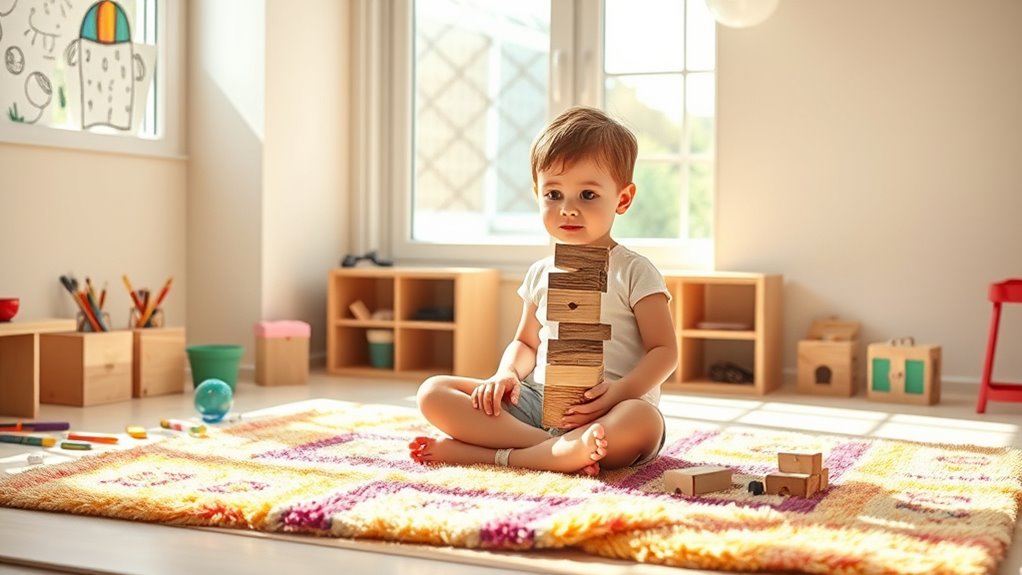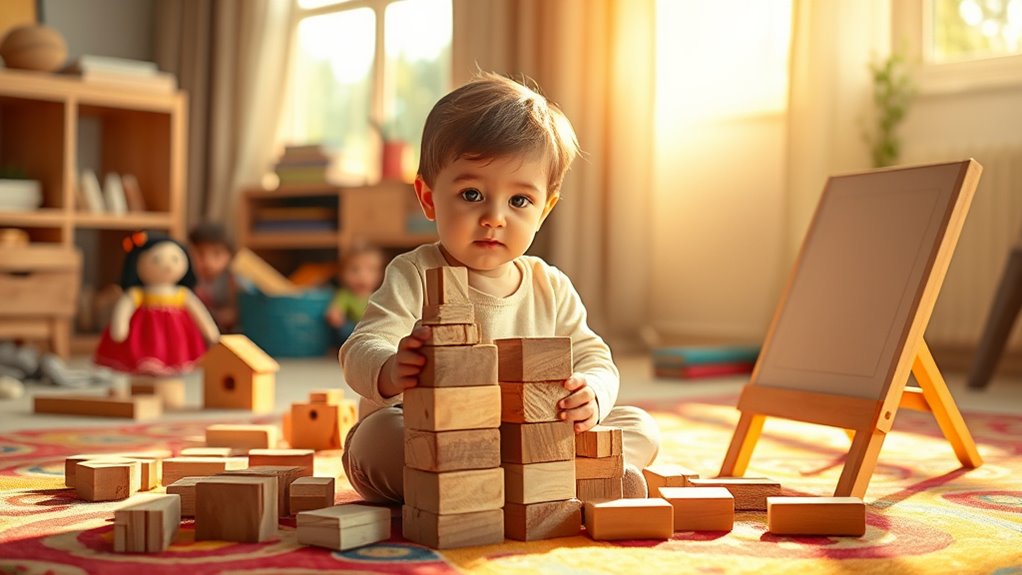Encouraging independent play helps your child build confidence, creativity, and resilience by exploring safely and making decisions on their own. Provide open-ended toys and a stimulating environment, then step back and observe. Ask guiding questions and celebrate their efforts, showing you trust their judgment. As they face challenges, they learn problem-solving and persistence. Keep supporting their growth gradually, and you’ll see how nurturing independence sparks their confidence—stay with us to find more ways to help this journey.
Key Takeaways
- Provide open-ended toys and a safe environment to inspire exploration and creativity.
- Avoid over-directing, allowing children to experiment and make mistakes independently.
- Use open-ended questions to encourage problem-solving and critical thinking during play.
- Establish regular solo play routines and celebrate progress to build confidence.
- Support resilience by praising efforts, not perfection, and encouraging persistence through challenges.

Encouraging independent play is essential for your child’s development, as it helps build confidence, creativity, and problem-solving skills. When your child explores on their own, they learn to trust their instincts and develop their sense of independence. The benefits of solo exploration extend beyond mere entertainment; it provides a foundation for critical thinking and resilience. As they navigate their environment, they discover how to manage challenges and make decisions without constant supervision. This process fosters a sense of achievement and boosts their confidence, knowing they can handle tasks independently.
One of the key advantages of encouraging independent play is how it nurtures problem-solving skills. When your child is left to figure things out on their own, they encounter obstacles that require them to think creatively and logically. Whether it’s building a tower with blocks, solving a puzzle, or figuring out how to get a toy out of reach, they learn to analyze situations and test different solutions. These experiences are fundamental, as they help your child develop resilience and persistence, understanding that setbacks are part of learning and growth. Over time, this builds their ability to approach complex problems with confidence and patience.
Encouraging independent play builds problem-solving, resilience, and confidence in your child’s growth and learning.
To foster these skills, create a safe and stimulating environment where your child feels comfortable exploring. Provide open-ended toys like building blocks, art supplies, or dress-up clothes that invite imaginative play. Resist the urge to overly direct or interrupt their activities; instead, observe and offer encouragement from a distance. This shows them that you trust their judgment and abilities. Giving your child space to experiment and make mistakes is indispensable for their problem-solving development. When they encounter difficulties, ask open-ended questions like, “What do you think you should try next?” or “How else could you approach this?” to promote independent thinking. Additionally, understanding the importance of resources and tools available for safe play can further enrich their experiences and support their growth.
Additionally, establish routines that include designated times for solo play, ensuring your child has regular opportunities to practice these skills. As they grow more comfortable exploring independently, gradually increase the complexity of their activities. Celebrate their successes and acknowledge their efforts, reinforcing the idea that they are capable of figuring things out on their own. Remember, the goal isn’t perfection but encouraging resilience and a growth mindset. By supporting solo exploration, you’re helping your child develop essential skills that will serve them well throughout life, empowering them to face new challenges with confidence and creativity.
Frequently Asked Questions
How Can Parents Balance Independent Play With Supervised Activities?
You can balance independent play with supervised activities by setting boundaries that give your child space to explore confidently. Provide options, like different toys or activities, so they feel in control. Keep supervision flexible, stepping in when needed but allowing autonomy. This approach helps your child develop creativity and confidence while ensuring safety. By establishing clear limits and offering choices, you foster independence without sacrificing your guidance.
What Are Signs of a Child Feeling Overwhelmed During Independent Play?
Think of your child’s feelings during independent play as a weather forecast. If their body language shows crossed arms, tense posture, or avoiding eye contact, it’s like dark clouds signaling overwhelm. Emotional cues like sighs, frowns, or frustration indicate they might be feeling anxious or overstimulated. Recognizing these signs helps you step in gently, offering comfort or a break, ensuring play remains positive and confidence-building.
How Do Cultural Differences Influence Independent Play Approaches?
Cultural differences shape how you approach independent play through cultural expectations and play material variations. In some cultures, you might emphasize collaborative play and family involvement, while others encourage solo exploration. You adapt your methods based on these norms, choosing different materials or setting specific boundaries. Recognizing these influences helps you support your child’s creativity and confidence, respecting their cultural background while fostering independence in ways that resonate with your values.
What Age Is Most Suitable to Start Encouraging Independent Play?
You should start encouraging independent play around age one, when your child hits early play milestones. Think of it as a daring adventure—only in a safe environment—where they learn to explore and build confidence. Waiting too long is like missing the fun train, so create safe spaces now. At this age, your little explorer begins to develop independence, fostering creativity and resilience for the journeys ahead.
How Can Caregivers Support Shy or Introverted Children During Independent Play?
You can support shy children during independent play by creating a safe, inviting environment that respects their comfort zone. Offer gentle encouragement and praise their efforts to build confidence. Introduce familiar toys and activities to help them feel secure. Gradually, give them time to explore on their own, knowing you’re nearby. This consistent support fosters confidence building and helps shy children enjoy independent play at their own pace.
Conclusion
By encouraging independent play, you’re helping your child build creativity and confidence that last a lifetime. When you step back and let them explore on their own, you’re giving them the gift of self-reliance. Are you ready to see your child’s imagination flourish and their confidence soar? Remember, sometimes the best way to support them is simply to let them play and discover the world on their own. Isn’t that the most empowering gift you can give?








